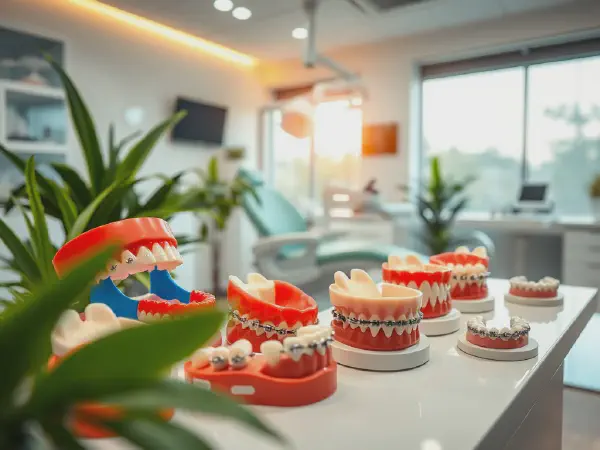Orthodontics: Improving Your Smile and Oral Health

Orthodontics: Improving Your Smile and Oral Health
Orthodontics is a branch of dentistry that focuses on correcting teeth and jaw alignment issues. It involves using various orthodontic appliances and techniques to straighten teeth, improve bite function, and enhance facial aesthetics. Orthodontic treatment can benefit people of all ages, providing them with a healthier and more confident smile.
Orthodontics has revolutionised dental treatments and is a vital aspect of dental health in today's world. Get to know more about Orthodontics at Mynt Dental , where expert care is extended to all patients.
One of the primary goals of orthodontics is to align teeth properly. When teeth are misaligned, it can lead to various oral health problems, such as gum disease, tooth decay, and difficulty in chewing and speaking. By addressing these issues, orthodontic treatment can improve oral health and prevent future dental problems.
The science of Orthodontics goes beyond simple teeth alignment. Dig deeper into this fascinating field with the comprehensive Orthodontic solutions . Understand the nitty-gritty of braces, retainers and other tooth correction aids and make an informed decision.
Orthodontic treatment is not limited to cosmetic improvements. It can also have a significant impact on an individual's overall well-being. Having a straight and well-aligned smile can boost self-confidence and positively affect social interactions and job prospects.
There are several types of orthodontic treatment available, depending on the individual's specific needs and preferences. The most common type is braces, which consist of metal or ceramic brackets and wires that gradually move the teeth into their proper positions. Clear aligners are another popular option, providing a more discreet and removable alternative to traditional braces. Lingual braces, attached to the back of the teeth, are also available for those seeking a more hidden treatment option. Orthodontic headgear might be necessary in some cases to correct severe jaw misalignments.
Common orthodontic issues that can be addressed with treatment include overbite, where the upper teeth overlap the lower teeth; underbite, where the lower teeth protrude beyond the upper teeth; crossbite, where the upper and lower teeth don't align properly; open bite, where the front teeth don't make contact when biting down; crowding, where there is insufficient space for the teeth to align properly; and spacing, where there are gaps between the teeth.
Types of Orthodontic Treatment
Braces: Braces are the most traditional and well-known orthodontic treatment. They consist of metal or ceramic brackets that are bonded to the teeth and connected by wires. Braces gradually apply pressure to move the teeth into their proper positions.
Clear Aligners: Clear aligners, such as Invisalign, are a popular alternative to braces. They are custom-made, transparent trays that fit over the teeth. Clear aligners are removable and offer a more discreet treatment option.
Lingual Braces: Lingual braces are similar to traditional braces, but the brackets and wires are attached to the back of the teeth. This makes them virtually invisible from the front.
Orthodontic Headgear: Orthodontic headgear may be required for certain cases of severe jaw misalignment. Headgear applies external force to the teeth and jaw to guide growth and correct alignment.
Common Orthodontic Issues
Overbite: An overbite occurs when the upper front teeth excessively overlap the lower front teeth. This can lead to improper jaw alignment and potential jaw joint problems.
Underbite: An underbite is characterized by lower front teeth that protrude beyond the upper front teeth. This misalignment can result in difficulty biting and chewing, as well as aesthetic concerns.
A smile builds bridges, but a confident one can win hearts. At Mynt Dental , we believe in honing that confidence with our skilled Orthodontic treatments. Join us in this mission and find out more about the power of a perfect smile.
Crossbite: Crossbite is a condition where the upper and lower teeth don't align properly. It can cause jaw pain, uneven wear on teeth, and potential gum disease.
Are you ready to adorn your best smile yet? Yes, it's now possible to achieve with advanced Orthodontic treatments. Find out more about Orthodontics and its benefits by visiting our official Facebook page .
Open Bite: An open bite is when the front teeth don't make contact when biting down. It can interfere with speech and cause problems with biting and chewing.
Crowding: Crowding occurs when there is insufficient space in the mouth for the teeth to align properly. This can lead to overlapping, rotated, or twisted teeth.
Spacing: Spacing refers to gaps between teeth. It can be caused by missing teeth, undersized teeth, or a combination of factors. Spacing issues can affect the appearance and function of the teeth.
Orthodontic Procedures
Initial Consultation: The orthodontist will conduct a thorough examination of the teeth and jaw, take X-rays, and discuss the patient's concerns and treatment goals.
X-rays and Impression: X-rays provide a comprehensive view of the teeth and jaw, allowing the orthodontist to create a personalized treatment plan. Impressions are taken to create models of the teeth.
Treatment Plan: Based on the examination results, X-rays, and impressions, the orthodontist will develop a treatment plan tailored to the patient's specific needs and goals.
Placement of Orthodontic Appliances: Braces, aligners, or other orthodontic appliances will be applied to the teeth. The orthodontist will ensure a proper fit and provide instructions on care and maintenance.
Adjustments and Aligning: Regular appointments will be scheduled for adjustments to the orthodontic appliances. Over time, the teeth will gradually align into their ideal positions.
Retention Phase: After the teeth are properly aligned, a retention phase begins. This phase involves using retainers to maintain the new position of the teeth and prevent regression.
Benefits of Orthodontic Treatment
Improved Oral Health: Straight teeth are easier to clean, reducing the risk of gum disease, tooth decay, and other oral health issues.
A journey towards a more confident smile begins here. Click here to see how our Orthodontics treatments at Mynt Dental have transformed smiles and lives alike. Your journey to a perfect smile is just a click away.
Enhanced Aesthetics: Orthodontic treatment can significantly improve the appearance of the smile, boosting self-confidence and overall facial aesthetics.
Enjoy a wealth of information on the field of Orthodontics. Understand more about these methods and process on our Instagram account , where we shall take you through the journey step-by-step.
Better Bite and Chewing Function: Properly aligned teeth improve bite function, making it easier to chew food and reducing strain on the jaw joints.
Remember, Orthodontics is more than just a solution. It's a journey towards a healthier, confident smile. Begin your journey with us today.
Prevention of Dental Problems: By addressing misalignments and overcrowding, orthodontic treatment can prevent future dental problems and the need for more extensive dental work in the future.
Boost in Self-Confidence: A straight and attractive smile can enhance self-esteem and improve social interactions and professional opportunities.
Orthodontic Appliances
Traditional Metal Braces: These are the most common type of braces and consist of metal brackets and wires. They are effective and suitable for a wide range of orthodontic issues.
Ceramic Braces: Ceramic braces are similar to traditional metal braces but have tooth-colored or clear brackets that blend in with the teeth for a more discreet appearance.
Invisalign: Invisalign is a popular clear aligner treatment that offers a virtually invisible and removable alternative to braces. It is suitable for mild to moderate orthodontic cases.
Self-Ligating Braces: Self-ligating braces use special brackets that don't require elastic or metal ties. This reduces friction and discomfort throughout the treatment process.
Orthodontic Retention
Retention Appliances: After completing orthodontic treatment, retention appliances such as retainers may be used to maintain the new alignment of the teeth.
Wearing Retainers: It is essential to wear retainers as instructed by the orthodontist to prevent the teeth from shifting back to their original positions.
Importance of Retention Phase: The retention phase is crucial to ensure long-lasting results. It allows the jawbone and surrounding tissues to adapt to the new tooth positions.
